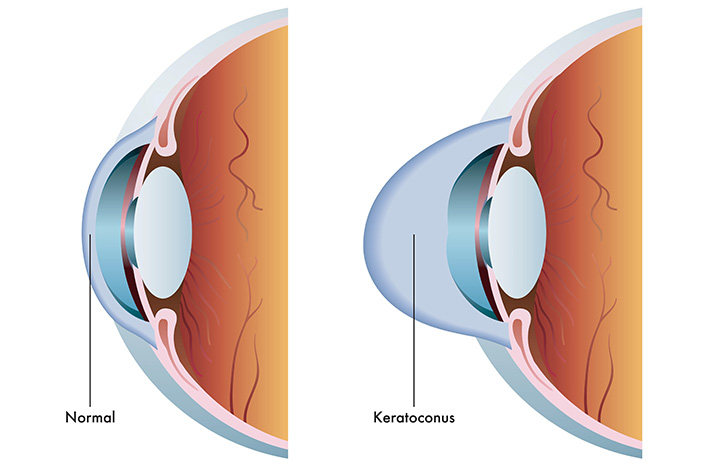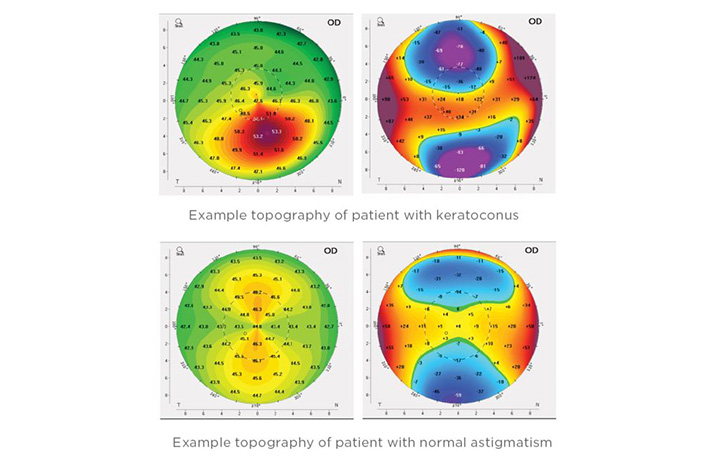Keratoconus and Corneal Cross Linking
-
What is Keratoconus?
The cornea is the clear, dome-shaped tissue that sits above the colored part of the eye, the iris. With keratoconus, the cornea becomes progressively thinner over time. This results in a bulging forward of the cornea. The cornea is responsible for about 2/3 of the focusing power of the eye. Therefore, the irregular astigmatism produced by the bulging of the corneal results in blurred vision. This can affect one’s ability to drive, read and watch tv.
Early on, keratoconus results in a slight blurring of one’s vision. Symptoms often begin in one’s teenage years. As the condition progresses over the next 10-20 years, one’s vision becomes blurrier. Each eye may progress at different levels.
-
Symptoms of Keratoconus
- Blurry or distorted vision
- Glare
- Light sensitivity
- Frequent changes in one’s glasses or contact lens prescription
- Inability to wear contact lenses
How is Keratoconus Treated?

-
Medical Contact Lenses
Custom contact lenses such as rigid gas permeable lenses and scleral lenses can help provide clear, comfortable vision in keratoconus patients. These lenses are designed to mask the irregular corneal curvature, resulting in improved vision. The doctors at Summit Eye Center work with several doctors who specialize in the fitting of these unique lenses.
-
Corneal Cross-Linking
Corneal cross-linking is a minimally invasive, FDA approved, treatment for keratoconus. It is an outpatient procedure that involves applying the combination of riboflavin (vitamin B2) eye drops and ultra-violet A (UVA) light to the eye. The effect of this treatment is to reinforce the collagen fiber links within the cornea. The goal of this treatment is to stabilize and strengthen the cornea in order to decrease or possibly halt the progression of keratoconus. By doing so, we hope to prevent the need for more aggressive treatments like a corneal transplant.
-
Corneal Transplant
A corneal transplant or penetrating keratoplasty (PK) is the most aggressive treatment for keratoconus. It involves removing the damaged tissue from one’s cornea and replacing it with donor tissue, which is sutured into place. This procedure is performed when no other treatment is an option. Recovery is quite long, up to a full year much of the time.
Summit Eye Center has been performing corneal cross-linking since 2015 through participation in clinical trials and now as a Food and Drug Administration (FDA) approved procedure. Cross-linking is a perfect fit for our doctor’s ongoing commitment to improving and protecting our patient’s vision for their lifetime.
Day of Procedure Expectations
 Plan on being at the office for around 2 hours
Plan on being at the office for around 2 hours- Numbing drops will be instilled in the eye
- The cornea will be prepared for the procedure
- Riboflavin drops will be applied to the eye
- The cornea will be exposed to UVA light source
- A bandage contact lens will be applied to the eye
- You will return to the comfort of your home to recover
Corneal Cross-Linking FAQ
-
How long does the procedure take?
The procedure takes about 1 hour, but plan on being at the office for a couple of hours. This extra time allows for preparation prior to the procedure and recovery before you return home.
-
Am I awake during the procedure?
Yes, you are awake during the procedure.
-
Does the procedure hurt?
The procedure itself does not hurt. You will receive some numbing eye drops to prevent discomfort during the procedure. There is some discomfort during the early recovery period. A bandage contact lens is placed on the eye to protect the eye. When the numbing medications wear off, there is some grittiness and mild burning sensation that can be managed through the use of artificial tears.
-
What is riboflavin?
Riboflavin (vitamin B2) is naturally found throughout our body, including the eye. It is a photosensitizer, meaning that when it absorbs light in the presence of oxygen it produces a reaction that strengthens chemical bonds within the cornea.
-
What is ultra-violet A (UVA) light?
UVA, UVB and UVC are the 3 types of invisible light rays produced by the sun. UVA is the weakest of the three.
-
Will I need to stay out of my contact lenses after cross-linking?
Yes. You will typically need to stay out of your contact lenses for 2 weeks prior to the procedure. You will then get back into contact lenses about 1 month after the procedure.
Content reviewed by Kelsey J. Kleinsasser, O.D.


